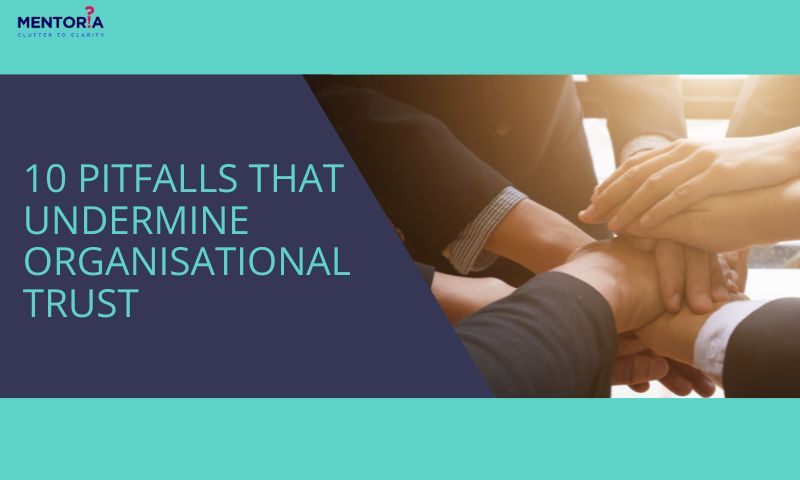10 Pitfalls That Undermine Organisational Trust

Jump to Section
People are generally wired to trust people, but when that trust gets broken, oh boy; it’s tough to regain. So why do they flip the switch on trust? Perhaps to dodge anything that might bring trouble our way? Whether in life or at work, who people trust can shape our paths in big ways. Take leaders and managers, for instance. Trust is like the glue holding the whole team thing together. When employees don’t trust the higher-ups, it’s like hitting pause on innovation. Imagine having a killer idea but feeling like it might get swiped or that your boss will snatch all the credit. That trust gap stops the good stuff from flowing.
Sometimes, leaders slip up, and those mess-ups? They hit the trust button hard. When leaders break that trust, it’s like pulling the rug out from under the whole team. Suddenly, it’s tough for employees to feel comfy sharing their game-changing plans or putting their all into their work. Building a culture of innovation? It’s all about trust. Without it, ideas stay locked up, and progress? Yeah, it takes a nosedive. Trust is the secret sauce for sparking creativity and making workplaces thrive. But it’s delicate. Leaders need to play their cards right, or that trust? Poof, it’s gone. We will look at factors such as avoiding choices, an utmost reliance on heroic employees, going behind new things and ideas, as well as a disengaged middle management. Other factors are not respecting people’s time, and how employees are scared of a Monday. Being comfortable with damage, people pleasing and tolerance for misalignment – all contribute to a reduction in trust.
Avoiding Making Choices
Avoiding making choices can stem from various factors. Sometimes it’s about fearing the consequences of not feeling confident about the available options. It’s like standing at a crossroads, unsure which path to take. One common reason is the fear of making the wrong choice. When the pressure to decide feels overwhelming, it’s natural to hesitate or delay the decision-making process. That fear of messing up can paralyse us, making it easier to procrastinate rather than face the uncertainty of a decision. Then there’s the analysis paralysis—having too many options or not enough information can make choosing seem impossible. It’s like staring at a menu with too many delicious dishes, and suddenly, you’re stuck unable to pick one.
Sometimes, avoiding choices can be tied to a fear of responsibility. Decisions come with consequences, and it’s easy to avoid that weight by letting someone else take the lead or by postponing decisions altogether. Finding ways to ease into decision-making can help. Breaking down choices into smaller, manageable steps can make them less intimidating. And remember, not making a choice is also a choice in itself—it’s just delaying progress or potentially missing out on opportunities. Consider a company facing a critical decision regarding a new product launch. The leadership team acknowledges the need to diversify their product line due to changing market trends. They brainstorm and outline several potential product ideas, each with its own set of pros and cons. However, when it comes to making the final decision, they hesitate and continuously delay the process.
Instead of committing to one product direction, they opt to keep all the ideas on the table, hoping to avoid making the tough call. This indecisiveness stems from a fear of potential failure or making the wrong choice. Consequently, the company ends up allocating resources to all the proposed ideas, spreading themselves too thin and lacking a clear focus on any single product. As a result, they may miss the market window for a successful launch or dilute their efforts, resulting in subpar products across the board. In this scenario, the organisation avoids making a clear choice by attempting to pursue multiple avenues simultaneously, leading to a lack of direction, wasted resources, and potentially missed opportunities for success.
Reliance on Heroic Employees
Relying on “heroic” employees,often called upon to save the day or consistently go above and beyond, might seem like a quick fix for certain situations. These individuals become the go-to solution for problems, the ones who can always be counted on to bail everyone out. However, this reliance on a few heroic figures can lead to several issues within an organisation.
Firstly, it can create an unsustainable work environment. These heroes might feel the pressure to constantly perform at their peak, leading to burnout or stress. They might also become bottlenecks, as everything gets funnelled through them, hindering overall productivity. Moreover, it can demotivate other team members. When certain individuals are always put on a pedestal, it can make others feel undervalued or less capable, which can harm morale and teamwork.
Relying solely on these heroes can also hide systemic issues within the organisation. Instead of addressing underlying problems or improving processes, the focus remains on these individuals as a band-aid solution. Encouraging a culture of collaboration and shared responsibility can help distribute tasks more evenly and empower all team members to contribute their best. Recognising and rewarding collective achievements rather than individual heroics can foster a healthier and more sustainable work environment. For example, if a tech startup that’s constantly working against tight deadlines to deliver their product to market have a small team of highly skilled developers who consistently pull off incredible feats to meet aggressive timelines. These developers are incredibly dedicated, often working long hours and sacrificing personal time to ensure the company meets its goals.
The company, however, starts to rely excessively on this handful of developers to carry the weight of the entire project. Whenever there’s a crunch or a critical issue, instead of reassessing timelines or optimising workflows, the company turns to these individuals, expecting them to work miracles to meet deadlines. Over time, these heroic employees become the go-to solution for every problem the company encounters. Their workload becomes unsustainable, leading to burnout and decreased productivity. Additionally, other team members start to feel undervalued, leading to resentment and reduced morale across the organisation.
In this scenario, the company’s reliance on a few heroic employees to consistently rescue projects becomes a detrimental practise. It not only leads to the burnout of these individuals but also creates an unhealthy work culture that doesn’t foster collaboration or distribute responsibilities effectively among team members.
Shiny Object Syndrome
“Shiny object syndrome” is that irresistible temptation to constantly chase after the newest, most exciting thing, whether it’s a trend, a project, or an idea. It’s like being drawn to shiny objects, unable to resist their allure. This syndrome often leads to constantly shifting focus, jumping from one thing to another without fully committing or seeing things through. It’s like having a dozen browser tabs open but never really delving deep into any of them.
While exploring new ideas and opportunities is great, this constant pursuit of the next big thing can be distracting and detrimental. It can hinder progress on current projects, disrupt workflow, and prevent long-term goals from being achieved. It’s essential to strike a balance between innovation and focus. Recognising the value of staying committed to ongoing projects while still allowing space for new ideas is key. Establishing clear priorities, setting goals, and evaluating whether a new endeavour aligns with overarching objectives can help avoid falling prey to the allure of every shiny object that comes along. For example, A marketing agency that has been diligently executing a comprehensive strategy to increase its online presence and engagement developed a content calendar, optimised their social media channels, and started seeing gradual but steady growth in their audience and conversions.
However, during a team meeting, someone introduces the idea of leveraging a new emerging social media platform that has gained popularity recently. The platform seems trendy and promising, and the team gets excited about the potential it holds for reaching a new audience. Instead of evaluating how this new platform aligns with their existing strategy or assessing its impact on their current efforts, the team becomes fixated on it. They divert resources, time, and energy away from their established strategy and start focusing heavily on this new platform.
As a result, the team’s attention becomes fragmented. They neglect the platforms where they were seeing consistent growth, their content calendar gets disrupted, and their overall online presence starts to suffer. Despite the initial enthusiasm for the new platform, they fail to achieve the anticipated results because their efforts were spread thin across multiple channels without a cohesive strategy. In this case, the Shiny Object Syndrome led the team to abandon their well-thought-out strategy in pursuit of a new, exciting opportunity, ultimately impacting their overall performance and progress.
Disengaged Middle Management
When middle management feels disconnected or disengaged, it’s like a vital link in a chain suddenly losing its strength. These managers serve as the crucial bridge between upper leadership and frontline teams, so when they’re disengaged, the effects can be felt across the organisation. First off, their disconnection can lead to a lack of direction. They’re the ones who translate the big-picture goals from top leadership into actionable steps for the teams they oversee. When they’re disengaged, it’s like having a GPS on mute—everyone’s moving but without a clear destination. Then there’s the impact on team morale. These managers are often the face of leadership for the teams they supervise. If they’re disengaged or distant, it sends a message that can affect motivation and enthusiasm among their teams. Disengagement in middle management can also lead to poor communication. They’re the linchpins for passing information up and down the hierarchy. If they’re not engaged, important messages might get lost in translation or not delivered at all.
It’s crucial to address this disengagement by understanding its root causes. It might stem from feeling disconnected from higher-ups, unclear expectations, or a lack of empowerment. Reconnecting these managers to the organisation’s vision, providing support, and involving them in decision-making processes can help reignite their engagement and, consequently, positively impact the entire workforce. For example, Company XYZ, a mid-sized technology firm, has a hierarchy comprising top-level executives, middle managers overseeing various departments, and employees within those departments. Initially, the middle management at Company XYZ was actively involved, driving initiatives, fostering team spirit, and aligning departmental goals with the company’s vision.
However, over time, due to factors such as limited opportunities for advancement, unclear communication from top leadership, and a lack of recognition, the middle management begins to feel disconnected and disengaged from the company’s objectives. These middle managers, responsible for translating the company’s vision into actionable plans, gradually become passive. They stop proactively seeking feedback or collaborating with upper management to align strategies. Instead, they focus solely on day-to-day operations, neglecting the bigger picture or long-term goals.
As a consequence, this disengagement affects the flow of information and decision-making within the company. There’s a noticeable gap between the aspirations of the company and the actions taken by the middle management. This results in lower employee morale, decreased productivity, and a lack of innovation within departments, as these managers are no longer actively promoting growth or change. Ultimately, the disengagement of middle management creates a ripple effect throughout the organisation, hindering progress, stifling innovation, and impacting the company’s ability to adapt and thrive in a competitive market.
Casual Relationship With Other People’s Time
A casual relationship with other people’s time is like treating it as a flexible commodity rather than a valuable resource. It involves being lax or indifferent about punctuality, commitments, or the impact your actions might have on someone else’s schedule.
This behaviour often manifests as consistently running late for meetings or appointments without consideration for others’ time. It can also include being unreliable with deadlines or not respecting boundaries, like interrupting or extending conversations or tasks without acknowledging the impact on others. Having a casual attitude toward other people’s time can strain relationships, breed frustration, and erode trust. It communicates a lack of respect for the value they place on their time and priorities. Imagine a marketing team within a company where meetings are a regular occurrence to discuss ongoing projects and strategies. One team member consistently arrives late to these meetings without a genuine reason. Despite the agreed-upon start time, they stroll in 10 to 15 minutes late, often causing delays in the discussions. Sometimes, he apologises briefly, but it becomes a recurring behaviour. This lack of punctuality becomes a norm for them, causing frustration among other team members who are prompt and ready to engage at the scheduled time.
Moreover, they don’t seem to value others’ time during these meetings, frequently interrupting ongoing discussions with unrelated comments or questions, derailing the agenda and causing further delays. They don’t consider the impact of his interruptions on the flow of the meeting or the time of his colleagues. Additionally, when assigned collaborative tasks with deadlines, they tend to procrastinate or miss deadlines without prior notice, which affects the workflow of the entire team. Their casual approach to time management impacts the team’s productivity, leading to missed opportunities and incomplete projects.
In this scenario, their casual attitude towards punctuality and respecting others’ time disrupts the team’s efficiency and undermines the collaborative efforts, causing frustration and hindering the team’s overall progress. Recognising the importance of others’ time and actively showing respect for it can make a significant difference. Being punctual, honouring commitments, and communicating effectively about any changes or delays can demonstrate consideration for their schedules and build stronger relationships based on mutual respect.
Comfort With Collateral Damage
Being comfortable with collateral damage essentially means being okay with unintended consequences or harm that affects others in pursuit of a goal or action. It’s like acknowledging the fallout but being willing to accept it as a side effect of achieving a primary objective.
This mindset often emerges when individuals or organisations prioritise their immediate goals without fully considering or acknowledging the potential negative impact on others. It might involve making decisions that benefit one group but inadvertently harm another, with the attitude that such consequences are acceptable or unavoidable in the pursuit of a larger goal. However, this comfort with collateral damage can be problematic. It can lead to ethical dilemmas, strained relationships, or long-term damage to reputation or trust. It might also create a culture where short-term gains overshadow the importance of ethical considerations and the well-being of others. In a highly competitive sales environment, a sales manager, Sarah to take an example, is under intense pressure to meet monthly targets set by upper management. In a bid to achieve these targets, Sarah adopts an aggressive approach, pushing her sales team relentlessly, often disregarding the impact on their work-life balance or well-being.
Sarah prioritises meeting the sales numbers above all else. She sets sky-high targets without considering the strain it puts on her team. She encourages working overtime, even on weekends, and frequently imposes last-minute urgent tasks, expecting immediate results regardless of the team’s existing workload. In this high-stress environment, some team members begin experiencing burnout and stress-related health issues due to the constant pressure. Despite noticing signs of distress among her team, Sarah remains singularly focused on achieving her sales targets, considering any personal setbacks or health issues as a necessary sacrifice for meeting company goals.
Moreover, Sarah’s approach affects team dynamics. High turnover rates become the norm as employees struggle to cope with the demanding work environment. Morale drops, and those who remain feel disengaged and unmotivated, impacting their performance and overall productivity. In this scenario, Sarah’s comfort with collateral damage, such as sacrificing her team’s well-being for the sake of meeting sales targets, creates a toxic work environment, leading to burnout, high turnover, and diminished team morale.
Balancing objectives with an awareness of potential consequences and actively seeking ways to minimise or prevent harm is crucial. It involves taking responsibility for the broader impact of actions and decisions and striving for solutions that align with ethical principles and respect for all stakeholders involved.
High Incidence of the “Sunday Scaries”
The “Sunday scaries” refer to that sinking feeling or anxiety that creeps in as the weekend winds down, signalling the impending start of the workweek. It’s like a dark cloud looming over what should be a relaxing Sunday evening. This phenomenon often stems from various factors. For some, it’s the stress of anticipating a heavy workload or facing challenging tasks on Monday. Others might feel a sense of dread about returning to a toxic work environment or dealing with difficult colleagues or bosses.
Additionally, the pressure to transition from leisure time to a structured work routine can trigger anxiety or feelings of being overwhelmed. It’s like suddenly switching gears from relaxation mode to full-on work mode, which can be jarring. Addressing the Sunday scaries involves finding strategies to ease this transition and manage the underlying causes of stress. Planning ahead on Fridays, creating a to-do list for Monday, or engaging in relaxing activities on Sunday evenings can help ease the anxiety. It’s also essential to evaluate the root causes—whether it’s workload, workplace culture, or personal factors—and take steps to address them, seeking support if needed, to create a more manageable and less anxiety-inducing work environment. For example, Emily, a corporate professional, experiences the Sunday Scaries regularly. Throughout the weekend, she tries to unwind and spend quality time with family and friends. However, as Sunday evening approaches, a sense of unease creeps in. She starts worrying about the workload awaiting her on Monday, the pending deadlines, and the challenging meetings scheduled for the week. This anxiety disrupts her relaxation, making it difficult for her to enjoy her Sunday evenings fully. As a result, she feels mentally and emotionally drained before the workweek even begins.
People-Pleasing in the Boardroom
This involves prioritising satisfying others’ expectations or gaining their approval over asserting one’s opinions or standing firm on decisions. It’s like aiming to keep everyone happy rather than focusing on what might be best for the company or the situation at hand.
This behaviour can stem from a variety of reasons. Some individuals might feel a need to be liked or accepted, fearing conflict or pushback if they express opposing views. Others might lack confidence in their ideas or feel intimidated by higher-ranking board members, leading them to acquiesce to maintain harmony. However, excessive people-pleasing in the boardroom can have detrimental effects. It might lead to a lack of diverse perspectives in decision-making, hindering innovative ideas or critical discussions. It could also result in suboptimal decisions made to appease everyone rather than what’s truly best for the organisation. For Example, In a corporate board meeting, the CEO, Samantha, presents a new strategic direction for the company. The proposed strategy involves significant changes in operations and resource allocation to capitalise on emerging market trends. As Samantha presents her plan, she notices that some board members express reservations or ask critical questions about the feasibility and potential risks of the proposed strategy.
Among the board members, there is one individual, who has a history of people-pleasing behaviour. Mark is known for his tendency to always agree with the CEO’s proposals and avoid contradicting or challenging authority figures in meetings. During the discussion, despite having reservations about certain aspects of the proposed strategy, Mark refrains from expressing his concerns. Instead, he nods in agreement with the CEO and offers only positive feedback, even though he harbours doubts about the plan’s efficacy. His primary focus is on maintaining a harmonious atmosphere and avoiding conflict rather than contributing to a robust discussion or raising valid concerns.
As a result, other board members might assume unanimous support for the proposed strategy, unaware of the genuine reservations that Mark or potentially others might have. This lack of diverse perspectives and critical feedback in the boardroom might lead to decisions being made without thorough scrutiny or consideration of potential pitfalls, ultimately affecting the company’s success. In this scenario, Mark’s people-pleasing behaviour inhibits constructive debate and the exploration of alternative viewpoints in the boardroom, potentially compromising the quality of decisions made by the leadership team. Balancing the need for collaboration and harmony with assertiveness and confidence in one’s ideas is crucial. Encouraging an open and inclusive culture where differing opinions are valued can help individuals feel more comfortable expressing their thoughts without fear of judgement. It’s also essential for individuals to build confidence in their expertise and opinions, understanding that constructive disagreement can lead to better outcomes than unanimous agreement.
Tolerance for Misalignment
Tolerance for misalignment refers to the level of acceptance or allowance within a group or organisation for differences in goals, values, or approaches. It’s like acknowledging that there are diverse viewpoints or strategies within a team or company and being okay with that divergence. At times, this tolerance can be beneficial, fostering a culture of diversity and accommodating various perspectives. It can encourage innovation and creativity, as different ideas collide and spark new solutions. It might also prevent unnecessary conflicts over minor differences and allow for flexibility in approaches to achieving shared goals.
However, too much tolerance for misalignment can pose challenges. If there’s excessive divergence in fundamental values or goals, it might lead to confusion, inefficiency, or even conflict. It could hinder progress when essential objectives or strategies aren’t aligned, impacting overall productivity and cohesiveness. The key lies in striking a balance—acknowledging and appreciating diverse perspectives while ensuring alignment on fundamental goals or values. Encouraging open communication, seeking common ground, and fostering a shared understanding of overarching objectives can help manage and leverage the benefits of diverse viewpoints without sacrificing unity or progress. For example, In a software development company, the executive team emphasises the importance of innovation and collaboration. However, the company’s performance evaluation system heavily emphasises individual productivity and output. Despite the company’s stated values of teamwork, employees are rewarded primarily based on individual achievements and output metrics, such as lines of code written or features developed. This misalignment between the company’s espoused values (innovation and collaboration) and the actual reward system (individual output-based evaluations) creates confusion and conflict among employees. Some employees prioritise personal achievements to meet performance metrics, while others focus on collaboration, leading to a disconnect in the desired behaviour and actual practises within the organisation.
Delusions of Meritocracy
Delusions of meritocracy refer to the belief that success or advancement within an organisation is solely based on merit, skills, or abilities, without acknowledging the influence of other factors like privilege, biases, or unequal opportunities. It’s like assuming that everyone has an equal starting point and that success is solely determined by individual effort and talent. This mindset can be problematic because it disregards systemic barriers that might prevent equal access to opportunities for everyone. It fails to recognise how factors like gender, race, socio-economic background, or personal connections can play a significant role in one’s advancement, often beyond individual merit alone.
Moreover, believing in a pure meritocracy might lead to a lack of acknowledgement or addressing of inequalities within the organisation. It can perpetuate a culture where those who succeed are assumed to be more skilled or deserving, while those facing obstacles are seen as lacking merit, disregarding the broader context. Acknowledging the existence of systemic biases and actively working towards creating a more equitable environment is crucial. Promoting diversity, providing equal access to resources and opportunities, and addressing biases in hiring and promotion processes are essential steps toward fostering a more genuinely meritocratic and inclusive culture within organisations. For example, In a corporate setting, a company boasts about its commitment to meritocracy, claiming that promotions and opportunities are solely based on individual performance and merit. However, in reality, the company’s leadership positions are predominantly held by individuals from similar backgrounds or social circles, regardless of merit.
Despite having employees from diverse backgrounds with impressive qualifications and performance records, they consistently face barriers in climbing the corporate ladder. The majority of promotions and high-level opportunities are consistently granted to individuals who share personal connections with upper management or belong to a specific demographic group, rather than solely based on their qualifications or performance. These instances of delusions of meritocracy perpetuate the false notion that the company operates in a fair and merit-based manner while favouring certain groups or individuals, creating a dissonance between the company’s proclaimed values and its actual practises.
In the intricate landscape of organisational dynamics, recognising pitfalls and addressing them is pivotal for sustained success. From the erosion caused by disengaged middle management to the allure of “shiny objects” and the complexities of trust and decision-making, each challenge presents an opportunity for growth. Navigating these challenges involves fostering a culture of open communication, mutual respect, and shared responsibility. Embracing diverse perspectives while aligning on fundamental goals and values creates a resilient framework for progress.
Embracing diversity and inclusivity, actively addressing systemic biases, and promoting transparency are foundational steps toward a more equitable environment. It’s through these collective efforts that organisations can move beyond the pitfalls, fostering environments where trust thrives, decisions are grounded in fairness, and each individual’s contribution is valued. Ultimately, it’s the collaborative commitment to growth and inclusivity that paves the way for sustainable success.
Building Trust With Mentoria
Trust is a vital ingredient for business success. It is essential for building strong relationships, attracting and retaining top talent, making good decisions, reducing costs, and enhancing reputation. Businesses that can foster a culture of trust are well on their way to achieving their long-term goals. Mentoria connects individuals with experienced mentors who can provide guidance, support, and encouragement. This can help mentees develop their skills, gain confidence, and make informed decisions about their careers. We also offer psychometric assessments that helps individuals identify their strengths, interests, and personality traits. This can be valuable for self-discovery and career planning.








